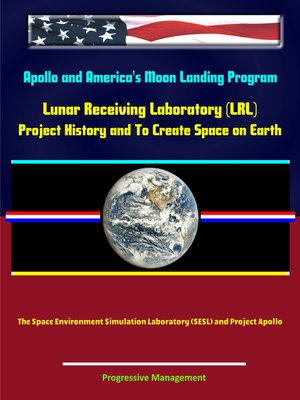Apollo and America's Moon Landing Program
ebook ∣ Lunar Receiving Laboratory (LRL) Project History and To Create Space on Earth: The Space Environment Simulation Laboratory (SESL) and Project Apollo
By Progressive Management

Sign up to save your library
With an OverDrive account, you can save your favorite libraries for at-a-glance information about availability. Find out more about OverDrive accounts.
Find this title in Libby, the library reading app by OverDrive.



Search for a digital library with this title
Title found at these libraries:
| Loading... |
These official NASA history documents - converted for accurate flowing-text e-book format reproduction - provide unique accounts of two Apollo-era facilities at the Johnson Space Center in Houston: the Lunar Receiving Laboratory (LRL) and the Space Environment Simulation Laboratory.
The first book, Lunar Receiving Laboratory Project History (NASA/CR-2004-208938) was written by Susan Mangus of Muskingum College and William Larsen of JSC in June 2004. As early as 1959, the Working Group on Lunar Exploration within NASA advocated that "one of the prime objectives of the first lunar landing mission should be the collection of samples for return to Earth, where they could be subjected to detailed study and analysis." Within NASA, neither this group nor any other scientists working with the Agency were concerned about back contamination issues. Outside of NASA, back contamination concerns had been raised as early as 1960. Although NASA did not seem to pay any attention to the concerns at that time, the scientific community continued to be interested in the topic. In 1962 and again in 1963, as the Apollo Program loomed large, further discussions were held. These early discussions of back contamination did not make their way into NASA's administration, however, and when Manned Spacecraft Center personnel began to articulate early concepts for the Lunar Receiving Laboratory (LRL), the back contamination issue was not considered. Once this concern became a major focus, however, the LRL's development became increasingly complex. This is the history of that development.
The second book, To Create Space on Earth: The Space Environment Simulation Laboratory and Project Apollo (NASA/CR—2003-208933) was written by Lori C. Walters, Ph.D. of the University of Central Florida in February 2003. Few undertakings in the history of humanity can compare to the great technological achievement known as Project Apollo. Among those who witnessed Armstrong's flickering television image were thousands of people who had directly contributed to this historic moment. Amongst those in this vast anonymous cadre were the personnel of the Space Environment Simulation Laboratory (SESL) at the Manned Spacecraft Center (MSC) in Houston, Texas. SESL houses two large thermal-vacuum chambers with solar simulation capabilities. At a time when NASA engineers had a limited understanding of the effects of extremes of space on hardware and crews, SESL was designed to literally create the conditions of space on Earth. With interior dimensions of 90 feet in height and a 55-foot diameter, Chamber A dwarfed the Apollo command/service module (CSM) it was constructed to test. The chamber's vacuum pumping capacity of 1 x 10-6 torr can simulate an altitude greater than 130 miles above the Earth. A "lunar plane" capable of rotating a 150,000-pound test vehicle 180 deg replicates the revolution of a craft in space. To reproduce the temperature extremes of space, interior chamber walls cool to -280°F as two banks of carbon arc modules simulate the unfiltered solar light/heat of the Sun. With capabilities similar to that of Chamber A, early Chamber B tests included the Gemini modular maneuvering unit, Apollo EVA mobility unit and the lunar module. Since Gemini astronaut Charles Bassett first ventured into the chamber in 1966, Chamber B has assisted astronauts in testing hardware and preparing them for work in the harsh extremes of space.






